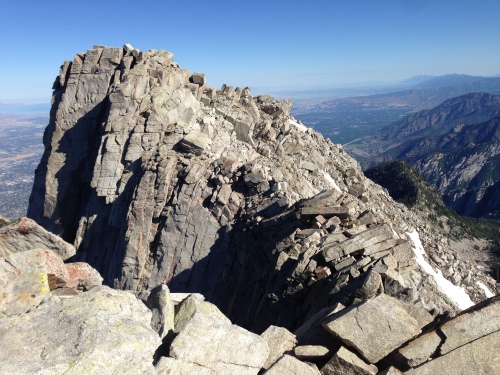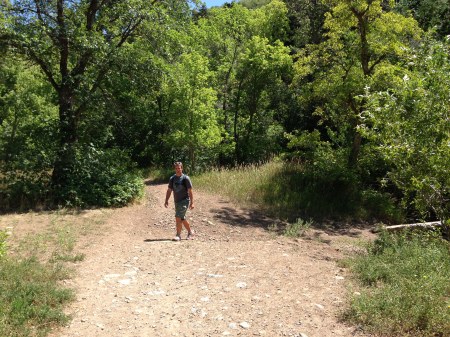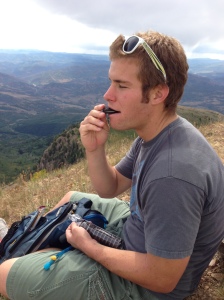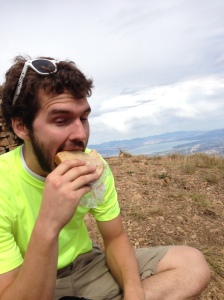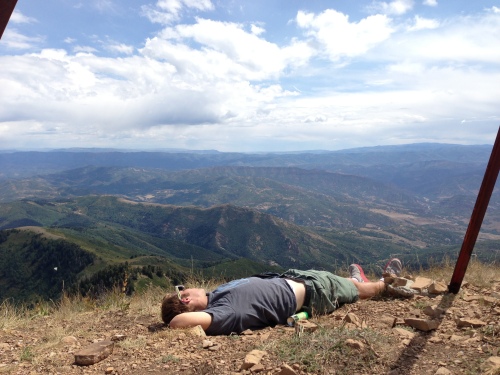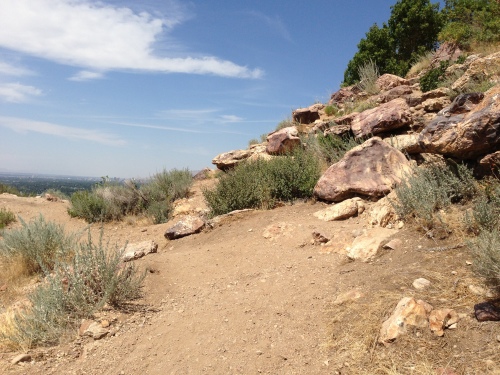Realizing we hadn’t planned something for our usual Tuesday hike and that doing Cascade would check off the last of Utah Valley’s 7 Peaks for me, my roommates and I more or less spontaneously decided to bag it.
Little did we know what we were in for.
I’m not sure if it was on the way up as we were bushwhacking our way over the umpteenth craggy, dense ridge hill (each one more mocking than the last, seemingly never turning into the true summit) or on the way down when all of us were out of water and ignoring how disgusting the snow we were melting to drink was, but at some point I decided those who say Lone Peak is the most challenging non-technical hike in Utah are full of it. Or, perhaps, like the vast majority of them, they haven’t done Cascade…or, if they have, they’ve decided it was worthy of being classified as technical.
At any rate, make no mistake: this is an extremely trying hike. You may notice, like I did, that experienced hikers posting trail reports mysteriously report a round trip time of 11 or 12 hours, despite similar length and elevation-gain hikes taking them 5 or 6. I say mysterious because, in my opinion, almost none of the trail reports out there properly warn you for what you’re about to face. For this reason, I think many take it for granted…myself included.
Don’t get me wrong, we did our best to prepare for what we knew would be a challenge, even with several peaks already under our belt this summer. Mentally we were ready for a trial (set what we thought was a realistic goal of 10 hours); our bags were full of food and at least 3L of water; we started as early as we could (7:30AM on the trail). However, it wasn’t meet for what Cascade throws at you.
There are a few different routes to get to the top; the most reliable one seemed to me to be the Dry Fork route, which is 9.5 miles up Squaw Peak road once you turn onto it from Provo Canyon (The second most promising, in my opinion, was the trail starting up past Vivian Park in the same canyon). Here’s a Google Maps pin: https://www.google.com/maps/dir//40.2689904,-111.5791157/@40.2703569,-111.6106604,6299m/data=!3m1!1e3!4m3!4m2!1m0!1m0
The first half of the trail is a decently steady slope, leading towards the ridge between Cascade and Freedom. You’ll start to get into some meadows, where many people see the gullys that head straight toward the ridge and diverge (we decided in advance that we wouldn’t diverge from the trail, having read so many stories of failed shortcut attempts). Past the meadows you’ll head towards the right (south), veering towards Freedom Peak, and Provo Peak just southwest of that. As you get directly below Freedom, you’ll switchback left, and start going up towards the ridge. As you get to the top, you’ll see a fork–stay left on trail 059 (the Dry Fork trail begins off Squaw Peak road as trail 060, for the record).
You have maybe 1/3 of a mile of trail left, mostly downhill. You’ll reach a small area where people appear to have camped, and see a strange, large (maybe 6′ by 10′) plastic basin-like thing (we wondered if maybe it was for catching rain water so people could filter it for the hike?). This is where the real fun begins.
Don’t underestimate what you’re about to attempt. Cascade doesn’t quit, and doesn’t give any mercy. I also suggest not trying to be clever about this. You’ll go up and down (my guess is the ~3,700ft you gain in this hike is probably closer to around 5,000 with the ups and downs of this ridge) over ridge peaks for around 3 miles, with tons of trees and loose ground that love to make things difficult for you. There is no trail. Yes, there are rough outlines of trails around, but many of them will lead you where you don’t want to go, so unless they are remarkably obvious and clearly lead where you want to go, be careful.
I think the best rule of thumb is to stick to the ridgeline as closely as possible. There are trails that look like they avoid unnecessary elevation gain on a ridge hill; they often just skirt halfway around it then force you to go straight up to the top over loose dirt and shale. I won’t pretend to know the best way to take this portion of the hike, but very, very rarely did I regret not just sticking as close to the highest point along the ridge as I could. It’s often where the path is cleanest, and overall requires the least amount of effort. You will run into areas where the ridge is totally blocked by thick brush and trees, but typically you just skirt right below that brush and come right back up.
Particularly on the way back we thought we could be clever, since now we’re heading downhill anyway, right? Wrong. Stay close to the ridge. It’s your best bet. Should you choose to take a gully shortcut, please carefully know your path via maps beforehand and be careful.
The first summit that completely convinces you you’ve reached the top is often the false south summit. There is a cairn and a registry in a small jar hidden nearby. However, the highest summit of cascade is still two ridge hills away (note again: two ridge hills. It was very disappointing to reach the first and realize it, once again, wasn’t the summit). The path between the south and north summits is likely the simplest path of the ridge. There is a cairn at the north summit as well.
Enjoy the summit. The views really are amazing, it’s a largely unobstructed 360 degree view. You can see all of Utah’s biggest peaks besides Lone.
Follow the same general guidelines on the way back. As I mentioned, we ran out of water, and this was a very mentally taxing return trip. One of our party started to feel some real pain as his shoes were wearing thin and his legs were getting charley horses. Once we were out off the ridge the sun was beating down on us, but we trudged through and actually did make our goal of 10 hours, arriving at the car just past 5:30PM.
Just doing the math with distance and elevation gain (about 6.5 miles one-way and gaining around 3,700ft), you have an average slope of 10.7%…however, this is entirely deceiving. If my guess of that reaching 5,000ft with the ridge hills is accurate, we actually have an average around 15.4%, and of course, it’s actually much steeper during the uphills, since some portions of the hike are downhill. In addition, there is more brush and pathfinding necessary to summit Cascade than any other hike I’ve done. I think I would qualify this as the most challenging peak I’ve done, even more than King’s or Whitney, especially from a mental perspective.
Please don’t underestimate this hike; but if you are feeling up to a real challenge, go get that view from the top. I will update this post with pictures and additional detail soon.



